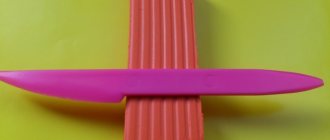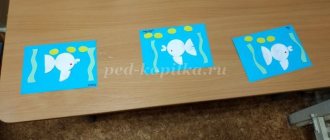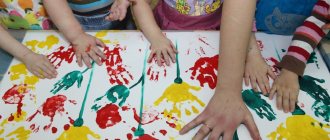Abstract of GCD modeling for 2nd junior group “Fishes swim”
Abstract of the educational activity “Fish swim in an aquarium”
Goal: To create conditions for developing the ability to pinch off a small piece of plasticine, roll it into a ball and flatten it on paper.
Tasks:
— Continue to teach children to pinch off small pieces of plasticine from a piece and roll them into balls. Press the ball with your index finger, attaching it to the base. Deepen children's knowledge about the life of fish.
— Develop memory, thinking, attention, speech, fine motor skills of the fingers.
— Cultivate interest in nature and display of impressions.
Materials: plasticine, fish cut out of paper, image of fish in an aquarium.
Integration of areas: social-communicative, cognitive, physical development.
GCD move
1. Organizational moment.
— Guys, guess the riddle:
Glistens in a clean river
The back is silver.
Who is this? (Fish)
- Now let's play: I will say pure sayings, and you will repeat after me.
Yes, yes, yes, the fish are in trouble in the water.
Yes, yes, yes, the whale is swimming here.
(Children repeat after the teacher)
2. Motivational moment.
We look at illustrations of fish,
- Guys, look what body parts do fish have and what shape? (All fish have an oval-shaped body, triangular fins and a tail covered with scales, eyes, a mouth).
- What size are the fish? (Big and small).
— Are the fish the same color? (I draw attention to the colors of the fish: bright, beautiful).
- In what direction are they swimming? (The fish swim in different directions: up, down, right, left).
- Guys, what can’t a fish live without? (This is water) .
- Do you know where the fish lives? (In a river, in the sea, in an aquarium).
- So, the fish has a body, a tail, fins, eyes, a mouth; it is covered with scales. Fish can be large and small, multi-colored, spotted, striped. They swim in the water in different directions: up, down, right, left.
There may also be algae, pebbles, and soil in the aquarium where fish can hide.
— Do you want to create your own aquarium and put fish in it?
3. Explanation of working methods.
We have different fish on the table. Take a close look at what our fish don't have? That's right, no scales. Together we will decorate our fish with colorful scales. We will make them from salt dough. Pinch off a small piece of dough from a large piece. Then we roll it into a ball. Press the ball with your index finger and attach it to the fish. The result is scales.
4. Summing up. - Well done! What beautiful fish you got! And now you will place them in our aquarium.
Modeling in the second junior group, theme “Fish”
Methodological development of joint activities between the teacher and children on artistic and aesthetic development using the non-traditional technique of working with plasticine (plasticineography) “Fish”. Age category: 3 – 4 years Author: Esaul Natalia Sergeevna, MKDOU Kantemirovsky kindergarten No. 2, teacher, 8-920-446-40-88 Relevance of the event: plasticineography is a universal method for developing aesthetic taste, fine motor skills of the fingers, and creative abilities of preschoolers of any age, which helps to comprehensively develop the child. Goal: developing the ability to create an expressive and interesting plot in half volume, using an unconventional technique of working with plasticine (plasticinography). Objectives: In the field of social and communicative development: Formation of skills of cooperation, independence, initiative In the field of cognitive development: Development of visual and figurative thinking, creativity, fantasy, aesthetic perception of the surrounding world In the field of speech development: Improving the lexical and grammatical structure of speech Development of dialogical speech In areas of artistic and aesthetic development: Formation of perception of the artistic word and art; Improving technical and visual skills. The use of waste material of various content and structure in the work In the field of physical development: Development of gross and fine motor skills Expected result: Formation of skills in working with plasticine, awakening interest in modeling. Mastering new techniques (rolling, pressing, smearing and creating plot pictures using various techniques). Learning to navigate on paper. Development of fine motor skills of the hands. Familiarization with the surrounding world. Development of emotions and fantasies. Methods and techniques: conversation (questions and answers), reading fiction (fiction); demonstration of visual aids (showing an illustration, showing a sample and methods of action); creating a problematic situation; physical education minute, finger play, plasticineography. Equipment and materials: Easel Illustration of a goldfish; Radio; Audio recording – “Sounds of the Sea”; Book “Tales of A. S. Pushkin”; A base with a drawn fish silhouette for each child; Plasticine of different colors; Oilcloths for modeling; Stacks; Hand wipes; Waste material: sequins, stones. Technologies used: Non-traditional drawing technique (plasticineography); Health-saving technologies; Integrated lesson technology. Preliminary work: Observing aquarium fish; Reading the fairy tale by A. S. Pushkin “The Tale of the Fisherman and the Fish”; Examination of illustrations for this work; Looking at pictures of marine life; Didactic games: “Who lives where? ", "Collect a picture"; Fish drawing; Listening to the musical recording of Saint-Saens “Aquarium”, imitation to the sounds of fish movement; Learning poems and solving riddles about the underwater world. Progress of joint activities: Activities of the teacher Activities of the children Organizational moment (forming a positive attitude for children to participate in the lesson) Guys, let's say hello to the guests and stand in a circle. All the children gathered in a circle, I am your friend and you are my friend, Let's hold hands tightly and smile at each other. I smiled at you, you smiled at me and your friend so that we would be in a good mood. Conversation on the fairy tale by A. S. Pushkin “The Tale of the Fisherman and the Fish” (clarification and expansion of the vocabulary on the topic, development of dialogical speech) An illustration depicting a goldfish is placed on the easel. Look guys, today a fish came to visit us. It’s not a simple fish, but what kind? She sailed from a fairyland. And to find out which fairy tale the fish is from, listen to the poem (the teacher reads an excerpt from the book “Fairy Tales of A.S. Pushkin): An old man lived with his old woman by the very blue sea; They lived in a dilapidated dugout for exactly thirty years and three years. The old man was catching fish with a net, the old woman was spinning her yarn. Once he threw a net into the sea, - The net came with nothing but mud. Another time he cast a net, and a net came with sea grass. The third time he cast the net, - The net came with one fish, With a difficult fish - a golden one. What fairy tale is this poem from? That's right, well done! This fairy tale was written by the great Russian poet Alexander Sergeevich Pushkin. Who can tell me why the goldfish in the fairy tale could make wishes come true? And those fish that live in an aquarium or in another body of water (river, lake, sea) can fulfill wishes? Tell me why Alexander Sergeevich called his fish golden? The scales that cover the body of the fish are large, shiny, and play in the sun, like gold. The golden fish, playing merrily, glitters with its scales under the sea wave. You correctly noted that in the fairy tale the fish is not ordinary, it is magical. Any desire can be fulfilled. Think about what you would ask a goldfish if you were able to meet it? But still, no matter what kind of sorceress the fish is, without what could it, like an ordinary fish, not be able to live? Right. Guys, do you know what fish need to feel comfortable in the water and be able to live normally? What do they need for breathing and nutrition? Do you think sand and stones are necessary for sea inhabitants or not? Guys, the goldfish invites you to swim in the sea. Physical education minute “Aquarium” (coordination of speech with movement, development of imitation) Turn around yourself and turn into a fish! The snails are crawling, carrying their houses. They move their horns and look at the fish. The fish swim, row with their fins. Turn left, turn right, and now it’s the other way around. Turn around and turn into kids! We rested a little, and now sit down at the tables. Practical part (plasticineography) Guys, I think that each of you would like to have your own magic fish to make your wishes for it. Today we will make fish, depicting them using plasticine, and to make the fish really look like gold, we will place sparkles - scales - on top of the plasticine. Stages of work: (Musical accompaniment sounds.) First, we fill the space inside the outline of our fish, smearing plasticine (of any light color) with a thin layer with your thumb or index finger. We do the same with the tail and fins. Glue the eye. Next we make the bottom. We will make algae from thin green columns. We attach shells and sea pebbles to the bottom using plasticine. During work, finger gymnastics “Fish” is performed (development of fine motor skills, coordination of speech with movement). And now we will rest a little and play with our hands: The fish swims in the water, The fish has fun playing. Fish, fish, mischief maker, We want to catch you. The fish bent its back and took a crumb of bread. The fish waved its tail, the fish quickly swam away. We finish our craft by decorating our fish: we lay out sparkles of the same or different colors close to each other in rows along the body of the fish. The final part (summarizing). Guys, what did we do in class today? Guys, let's look at your fish. Look how they turned out? You are absolutely right: the fish turned out bright, shiny, magical, with beautiful tails. They should have turned out different, because everyone made the fish for themselves. Now take your craft in your hand, look, the fish winked at you. Make your most cherished wish as soon as possible. Did you make a wish? Now wait, it will definitely come true. Thank you guys, you tried very hard today, that’s why you turned out such wonderful, beautiful crafts. Well done, you made me very happy. Now you can go and rest. Children greet guests and stand in a circle. Children read a poem together with the teacher. Golden. From "The Tale of the Fisherman and the Fish." She is magical, she could do miracles. No. It shimmers, shines, it is magical. Children's answers (offer their own options). Fish cannot live without water. They need algae. They need sand and stones to hide from big fish. Children perform the following movements: Move in a circle in a half-squat, with their hands folded behind their backs. They stop, make “horns” with their fingers, and rhythmically tilt their heads to the left and right. They move in a circle in small steps, lowering their arms along the body; movements only with your palms back and forth. Smooth turns of the body left and right and vice versa. Children perform movements and sit at tables. Children do their work to the music. They perform movements and pronounce words together with the teacher: With palms folded together, they depict how a fish swims. They shake their fingers. Slowly bring your palms together. Again they depict how the fish swims. Make a grasping movement with both hands. They are “swimming” again. Children put glitter-scales on the body of the fish. Children's answers. After finishing work, the children put their crafts on the common table. Children offer their own options (different, beautiful, etc.). References: 1. Aleksakhin, N.: Learning to sculpt and paint / N. Aleksakhin / / Preschool education. - 1994. - No. 9. P. 23-27. 2. Belaya, A. E. Finger games for the development of speech of preschoolers / A. E. Belaya, V. I. Miryasova. - M.: Education, 2002. 3. Bondarenko, T. M. Complex classes in the second junior group of kindergarten / T. M. Bondarenko. - Voronezh: Teacher, 2004. 4. Vainerman, S. M. Sensorimotor development of preschool children in fine arts classes / S. M. Vainerman, A. S. Bolshev, Yu. R. Silkin. - M.: Pedagogy, 2002.



